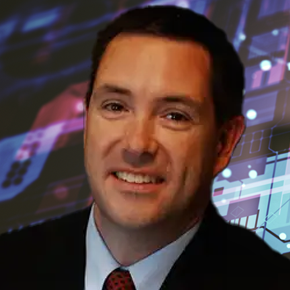June 9, 2023
How to Find ROI with PLM

Transcript
How to Ensure Return on Investment from PLM Software
Improving the throughput of the product development process — from CAD model to shipment — is the goal of every manufacturing company. In order to get the full return on investment you’re expecting from a PLM solution, simply buying a PLM software is not enough. You need to ensure that your entire product management team is operating as one — using the right SaaS tools, sharing the right product data and tracking the right metrics.
Leah Archibald: How can you make sure you’re set up for success? To answer this question, I turned to Chris Morris, Chief Customer Officer at aPriori Technologies. I caught up with Chris Morris at PTC LiveWorx, the technology showcase for PTC stakeholders. At this year’s LiveWorx, PTC and aPriori announced a high-level partnership to help customers get more return on investment from their PLM system by integrating workflows between aPriori and PTC. Leveraging both tools within one PLM solution, users of PTC can get insights into project costs, material reuse, and baseline CO2 all without leaving the PTC design software. This means they can design new products with an eye towards total cost, DFM, and net carbon, while also reducing engineering change orders and improving time to market.
I started my conversation with Chris Morris by asking him to describe his job at aPriori and what the new partnership between aPriori with PTC means for a customer’s return on investment from PLM software.
Chris Morris: I’m responsible for customer success at aPriori. That means making sure our customers achieve the ROI they’re expecting out of their solution, whether that’s cost savings or time to market or improved data management, or another metric that impacts profitability.
Leah Archibald: How does the new partnership between aPriori and PTC impact the return on investment that customers will see from their product lifecycle management solution?
Chris Morris: I spent a couple of decades at PTC in their services organization, and what I learned in that time is that no matter what PLM solution a customer is using, they’re all looking for the same bottom line value. Profitability is a driver no matter where you go. Customers are looking for a return on investment from their digital transformation initiatives, and they’re tracking the metrics that add up to success.
Return on Investment in PLM Software Means Getting Cost-Savings out of Product Lifecycle Management
Chris Morris: Return on Investment for anyone using a product lifecycle management tool means looking for improved profitability from their PLM solution. For users of PTC, they’re already using a digital thread to track product data through the product lifecycle. With aPriori added, they can now track product costs and other key metrics such as manufacturability and CO2. From product development through supply chain, they can now see the real-time impact of their decisions. That turns product lifecycle management into a profitability driver.
Leah Archibald: You’re responsible for making sure that a customer’s investment in digital transformation delivers return on investment in dollars and cents. Where does that process fall down? In other words, if a customer is not succeeding, what are the gaps that you’re trying to fill?
Chris Morris: That’s a great question. Quite honestly, when we find customers struggling, it really because of two reasons.
Change Management is Necessary for Return on Investment in Product Development
Chris Morris: The first reason a customer might not be seeing return on investment from their digital transformation is that the vision hasn’t been communicated well enough all the way down to the lowest levels of the organization. There’s a little bit of a gap in the change management process. This is where executives are critically important. Executives are the top change agents. They need to be communicating what ROI means for the organization, and how each person can contribute to the company’s profitability.
The second thing that we see in customers who have challenges is that the executives themselves are not pushing change management. It’s critical that executives help the organization make the move. Ultimately, this is a digital transformation that we’re talking about, and whenever there’s a transformation, it needs to be driven both from the top and from the bottom. We see return on investment when we have great executive sponsorship that focuses on the change, the adoption, the business processes, and the metrics. When they make sure people feel safe making changes, the change happens and we see fantastic results.
Leah Archibald: You’ve described two people-centric inputs to success. This is funny to me, because I thought you were going to say, “Customers don’t achieve return on investment when they don’t integrate legacy systems, or when their PLM system doesn’t talk to their ERP…” I expected some technology answer. But you gave me two answers that involve people. People are necessary for the digital transformation to be successful.
Chris Morris: Ultimately, that’s where the challenge really exists. We know that the technology works. We know that aPriori can integrate with PLM solutions. Those are technical challenges, and technical challenges that we’ve solved many times before. But where you need to go to get bottom-line results is to the stakeholders: the executives, the mid-level managers, all the way down to the users. Bringing that change into an organization is not something that happens naturally. It’s not “Field of Dreams.” Have you seen that movie?
Leah: “If you build it, they will come?”
Chris Morris: That’s right: “If you build it, they will come.” It’s my least favorite saying when it comes to software. Because, it’s not true. Just because you build a great product, doesn’t mean that people are going to use it. You have to bring stakeholders into the digital transformation. They need to know how this new product will help them improve profitability or time to market. They need to know why the change management is important for their company and how it is going to make an impact for their organization.
Bottom Line Results = What’s In It For Me?
Chris Morris: Have you ever heard the term WIIFM? What’s In It For Me?
Leah Archibald: WIIFM… I’m hearing it for the first time now, but I feel like it’s going to be very important to my life. WIIFM = What’s in it for me?
Chris Morris: Yes, What’s In It For Me. You need to address WIIFM at multiple levels within an organization. From an executive level, they’re the ones that have to become convinced that the change management is going to help the bottom line. But you also have to address return on investment all the way down to the user. So what do we do? We help them understand how the solution is going to make their job better, how it’s going to make them more effective, how it’s going to help them to drive better results, not just within their department, not across the entire company.
Leah Archibald: If you have a customer who is not seeing the return on investment, how would you start to fix the problem?
Chris Morris: The first thing you have to do is go back to basic principles. What is it that they’re trying to achieve? What are the outcome they’re trying to get? What are the metrics? What are the capabilities they have to have in place in order to ensure that those positive business outcomes are achieved?
Leah Archibald: Thank you for helping us define return on investment today.
Chris Morris: Thank you!







